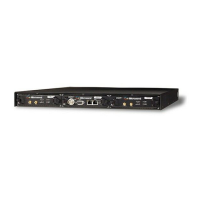28 TimeCreator 1000 User’s Guide 097-93100-01 Revision C – February, 2010
Chapter 1 Overview of the TimeCreator 1000
Overview
Output Signals
The TimeCreator 1000 passes frequency and TOD output through rear panel DTI
links. Ports 1 through 10 (12-port version) or Ports 1 through 6 (8-port option) are
permanent output ports. Ports A/11 and B/12 can be provisioned as either outputs
or inputs.
Communications Ports
The EIA-232 serial and Ethernet connections are located on the IMC. The EIA-232
serial and Ethernet connections allow you to provision the system from a terminal or
computer running a terminal emulation application.
Local Craft Serial Port
The EIA-232 port supports local control; you can configure the TimeCreator 1000
with commands using a terminal or personal computer (PC) with terminal emulation
software (see Communicating Through the Serial Port, on page 72). The connector
is located on the IMC. The Local port is configured as a DCE interface and the
default specifications are as follows:
8 data bits
1 stop bit
no parity
9600 baud rate (57600 is supported only in the IMC rev H version 1.00.13 or
below)
Flow Control: None
Ethernet
An Ethernet connector provides connectivity to a local area network (LAN) and each
port can be assigned a unique internet protocol (IP) address (see Communicating
Through the Ethernet Port, on page 72). Once the IP address is set and a
connection is made, you can access the TimeCreator 1000 on an intranet. The
Ethernet port supports two simultaneous connections to port 23.
Note: When ports A/11 and B/12 are provisioned as inputs, they are
referenced as ports A and B.

